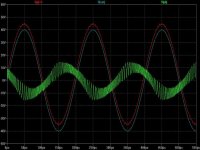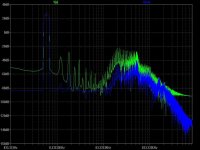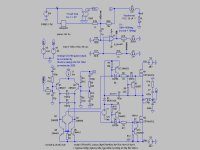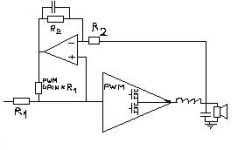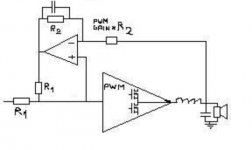Hi all
Has anybody tried or can tell if it is doable to subtact the exact amount of error at the input of a switching amplifier? M. Hawksford used something like this in linear mode followers, the idea is to get the error signal from output and subtract not in sense of classic feedback.
You know what I mean- input signal minus distortion gets amplified by distorting amplifier...
regards
Adam
Has anybody tried or can tell if it is doable to subtact the exact amount of error at the input of a switching amplifier? M. Hawksford used something like this in linear mode followers, the idea is to get the error signal from output and subtract not in sense of classic feedback.
You know what I mean- input signal minus distortion gets amplified by distorting amplifier...
regards
Adam
I think I know what you are thinking about. I believe that would require a very advanced DSP and a load sensor to instruct the DSP + a complete program telling the DSP all it needs to know about the distortion at different levels, loads, frequencies, interacting frequencies and so on.
darkfenriz said:
Has anybody tried or can tell if it is doable to subtract the exact amount of error at the input of a switching amplifier? M. Hawksford used something like this in linear mode followers, the idea is to get the error signal from output and subtract not in sense of classic feedback. You know what I mean - input signal minus distortion gets amplified by distorting amplifier...
Adam, I had a little trouble with your choice of words, but you seem to be describing what is known as feedforward. Unlike with high gain feedback, this method doesn't look at the difference between the input and the output, i.e., the feedback error and then amplify it as much as possible in an effort to drive it (the error) to zero. Feedforward looks at the disturbances outside outside of the error loop, sums them together in just the right quantities to equal what the error would have been without the feedforward signal. That way, there is (almost) no differencing error left for feedback loop to correct. If this is done perfectly, there is no need for a feedback loop at all. I think I've read that this sort of design was fairly popular for a time far in the past. Problem is, there is no correction for component drifts and the error cancellation signal being fed forward is no longer spot on. Feedback does not suffer this problem, so as soon as technology was able to provide enough gain-bandwidth, the feedback method completely won out.
This is unfortunate, because feedforward still has its merits and can go a long way toward reducing the workload of the feedback loop. I favor combining the two for the best of both worlds (kind of like "hot ice"
If you are interested, you can read about it in this thread, The "Leap-Frog" Method Of Switching Amplifier Control Loop Design.
Regards -- analogspiceman
snip
So let's say you combine both methods.... who's patent would that infringe upon again?
Hello,
one of them is Stochino (RM93. A000611-Sept1993)!
On the pic are 3 traces,
red: Output voltage of a simulated UCD180 (5kHz)
(Analogspicemans guess), for better viewing with small offset
grey: the corrected output
green: the output voltage of the small power correction amp with very high GBW.
Regards
Heinz
So let's say you combine both methods.... who's patent would that infringe upon again?
Hello,
one of them is Stochino (RM93. A000611-Sept1993)!
On the pic are 3 traces,
red: Output voltage of a simulated UCD180 (5kHz)
(Analogspicemans guess), for better viewing with small offset
grey: the corrected output
green: the output voltage of the small power correction amp with very high GBW.
Regards
Heinz
Attachments
powerbecker said:.....and this is the circuit. The delay line can be replaced with a buffered low pass ( 1k/ 2740pF).
Powerbecker, very nice! Thanks
darkfenriz said:Or this:
czesc Adam,
why not try to simulate this idea by yourself
Get SwitcherCAD from here:
http://www.linear.com/designtools/softwareRegistration.jsp
and extract the attachment in one file, it includes your floating opamp
Pozdrowienie
Heinz!
Attachments
- Status
- This old topic is closed. If you want to reopen this topic, contact a moderator using the "Report Post" button.
- Home
- Amplifiers
- Class D
- Question- post filter feedback error correction?
